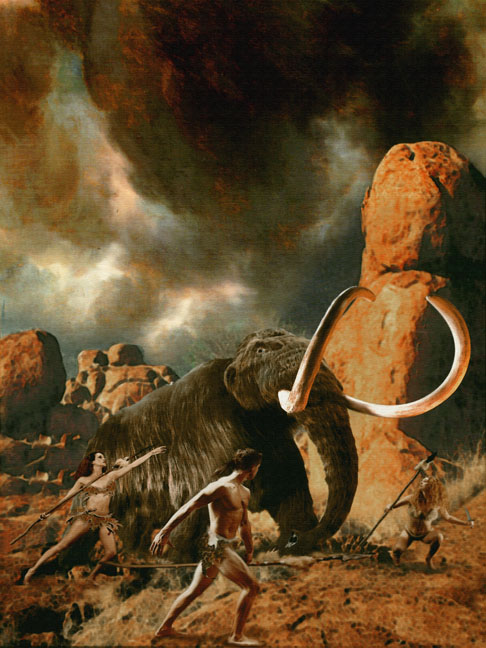



Posted on 09/27/2013 6:10:14 PM PDT by SunkenCiv
Dr Francis Wenban-Smith discovered a site containing remains of an extinct straight-tusked elephant (Palaeoloxodon antiquus) in 2003, in an area of land at Ebbsfleet in Kent, during the construction of the High Speed 1 rail link from the Channel Tunnel to London...
Excavation revealed a deep sequence of deposits containing the elephant remains, along with numerous flint tools and a range of other species such as; wild aurochs, extinct forms of rhinoceros and lion, Barbary macaque, beaver, rabbit, various forms of vole and shrew, and a diverse assemblage of snails. These remains confirm that the deposits date to a warm period of climate around 420,000 years ago, the so-called Hoxnian interglacial, when the climate was probably slightly warmer than the present day.
Since the excavation, which took place in 2004, Francis has been carrying out a detailed analysis of evidence recovered from the site, including 80 undisturbed flint artefacts found scattered around the elephant carcass and used to butcher it. The pre-historic elephant was twice the size of today's African variety and up to four times the weight of family car...
An ability to hunt large mammals, and in particular elephants, as suggested by the Ebbsfleet find, would go some way to explaining how these people then managed to push northwards again into what is now Britain. The flint artefacts of these pioneer settlers are of a characteristic type known as Clactonian, mostly comprising simple razor-sharp flakes that would have been ideal for cutting meat, sometimes with notches on them that would have helped cut through the tougher animal hide.
(Excerpt) Read more at sciencedaily.com ...
I can understand listing horse under a.. but it seems like there is something really fowl about democrats.
Those evil humans.
I hear you, mate. However, ever since I read that argument about how lobsters and shrimp are really just gigantic insects (carapice, six legs, invertebrate, antennas, non-irised eyes) I have not been able to even consider eating lobster again, although I used to love it.
I dunno about rhinos, but lions only became extinct in England fairly recently from what I am given to understand. Bears as well, I believe.
What species of hominin was in Englad 450,000 years ago? Weird, I have only thought modern humans have been found there.
Ummm... ‘ad-hominins’?
Probably Wooly Mammoth Toots.
I mean, of course; that’s why they are called “ad-hominin” attacks!
CaveMenforEthicalTreatmentofAnimals
keyboard spew alert
“Elephant I can handle, but how did rhinoceros and lion bones find their way so very far north?”
One step after another.




Ahhhhh but was it union labor.
They were purchased at Trader Joe’s?
The same way the elephants did. They walked in with the rest of the critter before sea levels rose and inundated the Channel.
Homo Heidelbergensis, or Homo Erectus, from among the known ones were around at that time.
Is that an elephant trunk, or were they just happy to see her?
The climate has changed. Weird, eh? Velikovsky discusses this in “Earth in Upheaval”.
The Caves of England -Page 15,
In 1823, William Buckland, professor of geology at the University of Oxford, Published his Reliquiae diluvianae (Relics of the flood), with the subtitle, Observations on the organic remains contained in caves, fissures, and diluvial gravel, and other geological phenomena, attesting the action of an universal deluge.
Buckland was one of the great authorities on geology in the first half of the nineteenth century. In a cave in Kirkdale in Yorkshire, eighty feet above the valley, under a floor covering of stalagmites, he found teeth and bones of elephants, rhinoceroses, hippopotami, horses, deer, tigers (teeth of which were larger than those of the largest lion or Bengal tiger), bears, wolves, hyenas, foxes, hares, rabbits, as well as bones of ravens, pigeons, larks, snipe and ducks.
Many of the animals had died 'before the first set, or milk teeth, had been shed.'
The idea which long prevailed, 'was, that they were the remains of elephants imported by the Roman armies. This is also refuted First by the anatomical fact of their belonging to extinct species of this genus, second, by their being usually accompanied by the bones of rhinoceros and hippopotamus, animals that could never have been attached to Roman armies: thirdly, by their being found dispersed over Siberia and North America, in equal or even greater abundance than in those parts of Europe which were subjected to the Roman power.'

...In the desert of the United Arab Emirates, there is an unusual series of flat discs imprinted in the sand. Each one is about 40 centimetres wide, and they snake off into the distance in several parallel lines, for hundreds of metres.
They are tracks. They were made by a herd of at least 14 early elephants, marching across the land between 6 and 8 million years ago. The track-makers are long dead, but in the intervening time, nothing has buried their tracks or eroded them away. Today, their social lives are still recorded in their fossilised footsteps.
March of the Ancient Elephants
(I question the dating, but obviously they lived in that region of what is now the UAE at a time when water and forage was abundant.)
Disclaimer: Opinions posted on Free Republic are those of the individual posters and do not necessarily represent the opinion of Free Republic or its management. All materials posted herein are protected by copyright law and the exemption for fair use of copyrighted works.